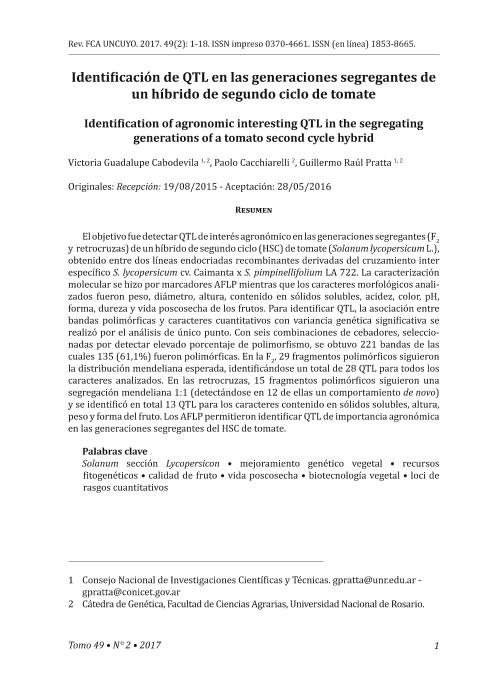Artículo
El objetivo fue detectar QTL de interés agronómico en las generaciones segregantes (F2 y retrocruzas) de un híbrido de segundo ciclo (HSC) de tomate (Solanum lycopersicum L.), obtenido entre dos líneas endocriadas recombinantes derivadas del cruzamiento interespecífico S. lycopersicum cv. Caimanta x S. pimpinellifolium LA 722. La caracterización molecular se hizo por marcadores AFLP mientras que los caracteres morfológicos analizados fueron peso, diámetro, altura, contenido en sólidos solubles, acidez, color, pH, forma, dureza y vida poscosecha de los frutos. Para identificar QTL, la asociación entre bandas polimórficas y caracteres cuantitativos con variancia genética significativa se realizó por el análisis de único punto. Con seis combinaciones de cebadores, seleccionadas por detectar elevado porcentaje de polimorfismo, se obtuvieron 221 bandas de las cuales 135 (61,1%) fueron polimórficas. En la F2, 29 fragmentos polimórficos siguieron la distribución mendeliana esperada, identificándose un total de 28 QTL para todos los caracteres analizados. En las retrocruzas, 15 fragmentos polimórficos siguieron una segregación mendeliana 1:1 (detectándose en 12 de ellas un comportamiento de novo) y se identificaron en total 13 QTL para los caracteres contenido en sólidos solubles, altura, peso y forma del fruto. Los AFLP permitieron identificar QTL de importancia agronómica en las generaciones segregantes del HSC de tomate. The objective was to detect QTL of agronomic interest in the segregating generations F2 and backcrosses of a tomato (Solanum lycopersicum L.) second cycle hybrid (SCH) obtained between two recombinant inbred lines derived from the interspecific cross S. lycopersicum cv. Caimanta x S. pimpinellifolium LA 722. Molecular characterization was achieved by AFLP markers and agronomic traits under study were fruit weight, diameter, height, soluble solids content, acidity, color, pH, shape, firmness and postharvest life. Single point analysis was applied to detect QTL, assessing the association of AFLP polymorphic bands and quantitative traits with significant genetic variance. Amplifications with six primers combinations, selected because of detecting high polymorphism percentage, 221 AFLP bands were obtained, and 135 (61.1%) of them were polymorphic in the tomato populations analyzed. In the F2 population, 29 polymorphic fragments adjusted to the expected mendelian segregation and a total of 28 QTL were detected for all evaluated traits. In the backcross population, 15 polymorphic fragments adjusted to the expected mendelian proportion 1:1 (12 of these fragments showed a de novo pattern) and a total of 13 QTL were identified for the traits soluble solids content, height, weight and diameter. AFLP allowed to identify QTL of agronomic interest in the segregating generations of a tomato SCH.
Identificación de QTL en las generaciones segregantes de un híbrido de segundo ciclo de tomate
Título:
Identification of agronomic interesting QTL in the segregating generations of a tomato second cycle hybrid
Fecha de publicación:
12/2017
Editorial:
Universidad Nacional de Cuyo
Revista:
Revista de la Facultad de Ciencias Agrarias de la Universidad Nacional de Cuyo
ISSN:
0370-4661
e-ISSN:
1853-8665
Idioma:
Español
Tipo de recurso:
Artículo publicado
Clasificación temática:
Resumen
Archivos asociados
Licencia
Identificadores
Colecciones
Articulos(IICAR)
Articulos de INST. DE INVESTIGACIONES EN CIENCIAS AGRARIAS DE ROSARIO
Articulos de INST. DE INVESTIGACIONES EN CIENCIAS AGRARIAS DE ROSARIO
Citación
Cabodevila, Victoria Guadalupe; Cacchiarelli, Paolo; Pratta, Guillermo Raúl; Identificación de QTL en las generaciones segregantes de un híbrido de segundo ciclo de tomate; Universidad Nacional de Cuyo; Revista de la Facultad de Ciencias Agrarias de la Universidad Nacional de Cuyo; 49; 2; 12-2017; 1-18
Compartir




